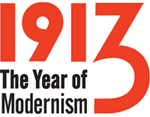L.2013.6.4 a-j: Revolving Doors
Between 1916 and 1917, the artist and photographer Man Ray created a series of collages he called "Revolving Doors." He included the series in his third solo exhibition at the Daniel Gallery in New York, in 1919. The collages, whose geometric shapes combine machine-like and anthropomorphic forms, were framed and installed on a rotating pole that the viewer could spin. The original collages were destroyed, but Ray later reproduced them in this series of stencil prints, published by Éditions Surréalistes in Paris.
When Man Ray exhibited the Revolving Doors, he wrote labels to accompany each work. He later published the entire series in the Surrealist periodical Minotaure 7 (1935). The original, typewritten document is in the collection of the J. P. Getty Museum, Los Angeles. Reprinted with permission from ARS/Artists’ Rights Society, New York.
The Revolving Doors:
The concern of a period of time often leads to the disappearance of material space. That is what the images in two dimensions shown here tend to prove; by a mutual action, they give birth to a series of events escaping from the control of all diversion.
Man Ray
New York, 1916–17
Man Ray
New York, 1916–17


















